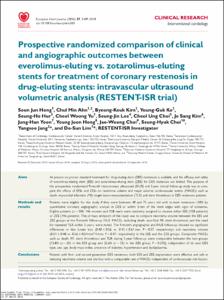KUMEL Repository
1. Journal Papers (연구논문)
1. School of Medicine (의과대학)
Dept. of Internal Medicine (내과학)
Prospective randomized comparison of clinical and angiographic outcomes between everolimus-eluting vs. zotarolimus-eluting stents for treatment of coronary restenosis in drug-eluting stents: intravascular ultrasound volumetric analysis (RESTENT-ISR trial)
- Keimyung Author(s)
- Hur, Seung Ho
- Department
- Dept. of Internal Medicine (내과학)
- Journal Title
- European Heart Journal
- Issued Date
- 2016
- Volume
- 37
- Issue
- 45
- Keyword
- Everolimus; Zotarolimus; Neointima; Restenosis
- Abstract
- Aims:
At present no proven standard treatment for drug-eluting stent (DES) restenosis is available, and the efficacy and safety of everolimus-eluting stent (EES) and zotarolimus-eluting stent (ZES) for DES restenosis are limited. The purpose of this prospective, randomized 9-month intracoronary ultrasound (IVUS) and 3-year clinical follow-up study was to compare the effects of EESs and ZESs on neointima volume and major adverse cardiovascular events (MACEs) such as death, myocardial infarction (MI), target lesion revascularization (TLR) and stent thrombosis in DES restenosis patients.
Methods and results:
Patients were eligible for this study if they were between 40 and 75 years old with in-stent restenosis >50% by quantitative coronary angiographic analysis in DES or within 5 mm of the stent edges with signs of ischaemia. Eligible patients (n = 304, 146 women and 158 men) were randomly assigned to receive either EES (158 patients) or ZES (146 patients). The primary endpoint of the study was to compare neointima volume between the EES and ZES groups at the 9-month follow-up IVUS. MACEs, including death, non-fatal MI, stent thrombosis and the need for repeated TLR within 3 years, were noted. The 9-month angiographic and IVUS follow-up showed no significant differences in late lumen loss (0.40 ± 0.56 vs. 0.45 ± 0.61 mm, P = 0.57, respectively) and neointima volume (0.51 ± 0.48 vs. 0.56 ± 0.54 mm3/1 mm, P = 0.47, respectively) in the EES and the ZES groups. Composite MACEs such as death, MI, stent thrombosis and TLR during 3-year follow-up were comparable between the two groups [15.8% (n = 25) in the EES group and 22.6% (n = 33) in the ZES group, P = 0.276], independent of de novo DES type, sex, age, body mass index, presence of diabetes, hypertension and dyslipidaemia.
Conclusions:
Patients with first- and second-generation DES restenosis, both EES and ZES implantation were effective and safe in reducing neointima volume and late loss with a comparable rate of MACEs independent of cardiovascular risk factors.
- Keimyung Author(s)(Kor)
- 허승호
- Publisher
- School of Medicine
- Citation
- Soon Jun Hong et al. (2016). Prospective randomized comparison of clinical and angiographic outcomes between everolimus-eluting vs. zotarolimus-eluting stents for treatment of coronary restenosis in drug-eluting stents: intravascular ultrasound volumetric analysis (RESTENT-ISR trial). European Heart Journal, 37(45), 3409–3418. doi: 10.1093/eurheartj/ehw389
- Type
- Article
- ISSN
- 0195-668X
- Appears in Collections:
- 1. School of Medicine (의과대학) > Dept. of Internal Medicine (내과학)
- 파일 목록
-
-
Download
 oak-2017-0111.pdf
기타 데이터 / 564.26 kB / Adobe PDF
oak-2017-0111.pdf
기타 데이터 / 564.26 kB / Adobe PDF
-
Items in Repository are protected by copyright, with all rights reserved, unless otherwise indicated.